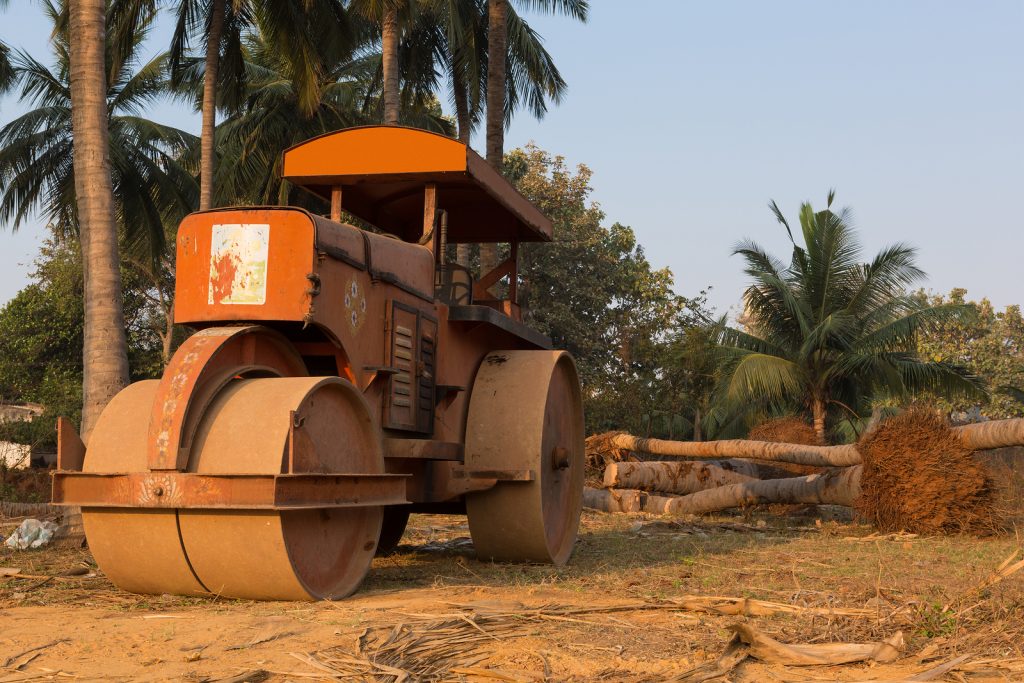When building new structures, existing trees are often the main features in your landscape design, and need to be carefully preserved. But how do we go about protecting trees during construction?
Unfortunately, many times pre-existing trees have difficulty surviving construction. This can lead to unsafe or hazardous conditions and expensive post construction removal costs. With planning, communication and cooperation, existing healthy trees can be preserved with minimal effort and expense. Trees need their roots protected during the construction process.
Plan With an Arborist
Always have a professional arborist involved in the planning (and maybe execution) of the project. Small changes in the placement or design of buildings, driveways or utilities can make a difference in protecting trees during construction. Alternative construction methods are generally easier than growing a new 20 year old tree. If utilities can’t be routed away from trees, tunneling or hand dug trenches are worth considering, to place the utilities directly below the trunk, where they do the least damage.
Inventory Your Trees
Map the location, species, size, and health of each tree on the development site. This can help you decide which trees to keep, which to remove and which to put limited effort into keeping. Your arborist can tell you which trees probably shouldn’t be selected for preserving. These should be removed prior to construction. Be sure to prune trees that need additional clearance to make room for future structures and construction equipment.
Tree Protection Zones
You’ll want to erect sturdy fencing around each tree that is to be preserved before construction starts. For each inch of trunk diameter, the fence should be about one foot from the trunk. So a ten inch diameter trunk gets fencing 10 feet from it. A three inch layer of mulch should be applied to the area within the TPZ. This provides your tree with both above and below ground protection.
Mount Tree Protection Zone (TPZ) signs to the fences and ask all construction personnel to keep fencing intact. No trenching, digging or soil disturbance of any kind should happen in the TPZ. No building materials, waste materials, excess soil, paints or supplies should be within the TPZ. The area should be considered off-limits.
Before Construction Starts
A healthy tree is more likely to survive the construction process than one that’s stressed. Be sure trees are receiving proper irrigation in addition to rainfall if needed. Prune dead, diseased, or hazardous branches. Also remove branches that will interfere with construction equipment and machinery.
Stay Engaged: Protecting Trees During Construction
Visit the construction site and inspect your trees on a regular basis. An arborist’s presence alerts workers that trees are important and their careful treatment is important. Should damage occur, begin repairs as soon as possible. Immediately inform the builder/contractor of any violations in the tree preservation plan and photograph any damage. All protective fences should remain in place until all construction workers have left the site.
Minimize Soil Compaction
Construction equipment and vehicles are a common cause of soil compaction. Have your project manager limit access points and designate routes on and off of the property. The fewer, the better. They should also designate areas for parking, storage of equipment, construction materials, excess soil, etc.
Grade Changes
Grade changes directly affect the roots of a tree. This happens either by removing roots when lowering the grade, or suffocating the roots when raising the grade. It can also change drainage, creating excess water in some areas and not enough in others. Except where absolutely necessary, do not change grade within the Tree Protection Zone. If raising the grade is necessary, we recommend not adding more than two inches of fill each year. Lowering the grade removes important roots and your rich topsoil. If a lowering of the grade is necessary, have your arborist root prune at least four to six months before construction starts and use a regular irrigation schedule before during and after root pruning.
Post Construction
It can take several years for trees to overcome and adjust to the injury that occurs during construction. These changes can be stressful, and trees that are suffering from stress are naturally more prone to insect and disease infestations than healthy trees. It is important to establish a long term maintenance program with your arborist to monitor and maintain the trees.
 Bringing Sexy Back Into Your Yards
Bringing Sexy Back Into Your Yards 
